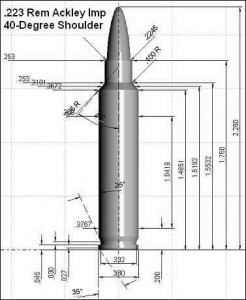 Wednesday Weapons Website of the Week is: Steve’s Pages cartridge information: diagrams and dimensons. We might have cited Steve Ricciardelli’s website before, but we’re pointing you at one page today: Steve’s Cartridge Dimension Page.
Wednesday Weapons Website of the Week is: Steve’s Pages cartridge information: diagrams and dimensons. We might have cited Steve Ricciardelli’s website before, but we’re pointing you at one page today: Steve’s Cartridge Dimension Page.
The need came up when we were recently handed an ancient Winchester Model 70 with an aftermarket barrel and an unusual marking: “.223 Ackley Improved.” The guy who owns the gun inherited it from a relative, who had in turn inherited it from somewhere. And the question was, what was it, and what could he shoot in it?
“I could google it, or I could ask you,”our friend said. (We’re flattered, but we know what he means. Not everything on the web is, shall we say, canonical doctrine).
P.O. Ackley was a gunsmith, gunwriter and serial cartridge wildcatter. His signature mark was to take a sporting or military cartridge and make it an “Ackley Improved,” by reducing the taper in the main body of the case, and steepening the angle of the shoulder. This increased case volume and, often, achievable velocities and energies. (It’s worth noting that Ackley himself often just named the cartridge “Improved,” but it became customary to add “Ackley” to give him credit).
The Ackley Improved cartridges (of which there are a great many) are improved from a hunter’s standpoint, perhaps, but there’s a reason the original cases were made with a less abrupt shoulder and more case taper in the first place: for best function in repeating, automatic, and semi-auto weapons. Therefore, Ackley’s ideas have been less influential in military than in civilian gunsmithery.
Gun Digest has a set of four articles on and by Ackley that will tell you a great deal about these interesting wildcat cartridges, that you can download by giving up your email address (and consenting for them to spam you with gun news, mostly new product press releases. You can always unsubscribe if the inbox clutter bugs you). Two W4 links for the price of one today! Enjoy.
Now, to our old Model 70. Reloading data for some of the Ackley Improved cartridges is in the major reloading manuals, and the cases can usually be fireformed from the source case — in this case (no pun intended), .223 or even 5.56 NATO brass (quality 5.56 cases might last longer after fire forming). You should be timid about using el cheapo surplus ammo for reloading, however, and you should give a particularly hairy eyeball to Russian-sourced ammo.
But the .223 AI is not in any of the major manuals. It has about 13% more case capacity than the SAAMI .223, and with light bullets is capable of some amazing speeds: 35 grain bullets can come out of the muzzle at over 4500 feet per second (and spinning at hundreds of thousands of RPM, making it a pretty good test of your bullet-maker’s core-jacket adhesion). Start with .223 data — not maximum loads — and work up to the .223 max load. Beyond that you’re on your own. Here are some .223 AI loads on Reloader’s Nest.
One should exercise care loading the .223 AI, for while SAAMI .223 is not loaded to high pressures, loads which reach the velocities of the military 5.56 round with equivalent bullet weights (i.e. your 3,000-fps-plus loads) may be creeping towards overpressure. This next caution is a bit of moot boilerplate, without any loads in the major (Speer, etc) manuals, but NEVER exceed the loads in the reloading manual, unless you’re prepared to experiment with an instrumented test weapon, strain gages, etc.
We’ve heard some scary things from chuckleheads who assume there’s some percentage of safety margin in published loading data. There isn’t. The stuff in the manual is the load that was tested and found safe. Exceed that, and you’re experimenting with something that can kill you.
While many have died to advance science over the centuries, you would be quite dead and most likely whatever data survived you would be incomplete and no use to anybody. So you will have died so as not to advance science. This is tantamount to the various death sequences that begin, “Hold my beer and watch this.”
If you have a use for a .223 AI rifle — prairie dogs, for example — that’s one thing. For the casual shooter the lack of available fixed ammunition makes it a bit of a curiosity (you can shoot commercial .223 ammo in it, which will probably be accurate, and will yield fireformed .223 AI brass). That poor Model 70 is worth less at resale now than it would have been with its original barrel, whatever it was; as a rule of thumb, you can’t sell something you customized extensively for what you paid for it. That would require you to find someone with the exact same tastes as yours.

Kevin was a former Special Forces weapons man (MOS 18B, before the 18 series, 11B with Skill Qualification Indicator of S). His focus was on weapons: their history, effects and employment. He started WeaponsMan.com in 2011 and operated it until he passed away in 2017. His work is being preserved here at the request of his family.
